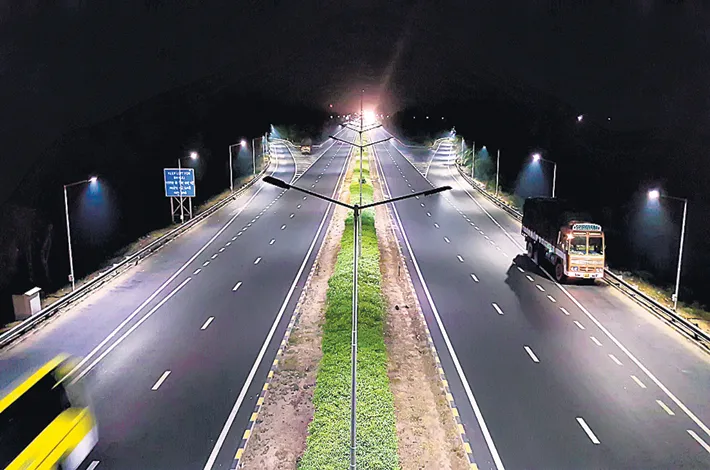Private Investment in Roads Hits Rs 1.2L Crore in 2024
03-06-2025 12:00:00 AM

Points to ponder
■ The road transport ministry’s assessment indicates that India will ultimately need around 50,000 kilometers of high-speed corridors to meet transportation demands. At present, only 3,900 kilometers of high-speed corridors are operational.
■ Once completed, the average travel speed of trucks on India's national highways is expected to rise to 85 km/h, up from the current 47 km/h.
Metro India News | Hyderabad
"American roads are not good because America is rich, but America is rich because American roads are good," said US President John F Kennedy once. India is rising and has taken up the building of roads with earnestness. Sample this: In FY24 alone, over 12,349 km of highways were constructed.
The National Highways Authority of India (NHAI) allocated a record INR 2,07,000 crore, a 20% increase in capital expenditure compared to the previous year. India now boasts the second-largest road network globally, spanning 66.71 lakh km as of January 2024, with an additional 13,000 km expected to be added by March 2025.
India’s roads and highways sector has witnessed remarkable growth, with the National Highways expanding at a CAGR of 9.3% from FY16 to FY24.
Private sector participation remains vital, especially through the Hybrid Annuity Model (HAM), where the government funds 40% of project costs and private developers contribute the rest. The Ministry of Road Transport and Highways (MoRTH) aimed to attract INR 35,000 crore in private investments for FY24-25, with overall sector expenditure projected to grow by 1%. The Pradhan Mantri Gram Sadak Yojana (PMGSY) has significantly enhanced rural connectivity, constructing over 7,65,600 km of roads. Its Phase IV will ensure all-weather access to 25,000 rural habitations.
Despite impressive progress, challenges such as land acquisition hurdles, environmental clearances, and project delays persist. The government is implementing reforms, alternative land acquisition methods, and streamlining clearance processes. Technological innovations—including satellite toll collection, AI-driven traffic management, and self-healing roads—are enhancing infrastructure efficiency.
A planned investment of INR 22 lakh crore aims to upgrade expressways, high-speed corridors, and urban infrastructure by 2031-32. The PM Gati Shakti initiative and AI-based logistics solutions are expected to further optimize freight movement and economic growth.
Government budget allocations for roads and highways continue to rise. In FY23-24, MoRTH spent INR 2,75,986 crore, exceeding the initial budget of INR 2,70,435 crore. Projections for FY25-26 indicate a further 2% increase, reaching INR 2,87,333 crore, primarily dedicated to NHAI and road infrastructure projects.
During FY23-24, India completed 426 road and highway projects worth INR 3,14,345 crore, with the West Zone leading construction activity at INR 1,66,777 crore across 122 projects. The EPC model was used in 57% of these projects, dominating project implementation.
Private investments remain strong, with INR 1.2 lakh crore worth of projects awarded in 2024 via HAM. MoRTH’s target of INR 35,000 crore for private PPP investments reflects a 17% increase from the previous year. Asset monetization peaked at Rs 40,314 crore, indicating investor confidence.
Initiatives like Bharatmala Pariyojana and PMGSY continue to drive infrastructure expansion. Bharatmala awarded 26,425 km of roads, constructing 17,411 km with an expenditure of INR 4.59 lakh crore. Over five years, NHAI contributed 24,050 km, creating numerous employment opportunities. PMGSY sanctioned 8,10,250 km and constructed 7,65,604 km at a cost of Rs 3,24,186 crore.
Environmental policies such as the Green Highways Policy have emphasized sustainability, resulting in the planting of over 402 lakh saplings. Infrastructure enhancements include GNSS-based tolling and over 5,293 EV charging stations, with plans for an additional 5,833 stations supported by INR 800 crore in subsidies.
The sector’s demand is surging, driven by increased automobile manufacturing and rising domestic trade. Passenger vehicle sales reached 4.2 million units in FY24, while logistics markets are projected to hit USD 484.43 billion annually.
Government incentives like 100% FDI allowance and tax exemptions have bolstered investments. The PM Gati Shakti initiative has identified 208 major projects worth USD 180 billion, focusing on critical infrastructure gaps. High-speed corridor projects totaling 936 km are planned with investments of INR 50,655 crore.
Technological advances—including AI traffic management, drone surveillance, self-healing asphalt, and mountain engineering techniques—are improving infrastructure quality. AI tools like iRASTE and iRAD enhance safety and risk assessment.
Challenges such as land acquisition, environmental approvals, and project delays demand ongoing attention. MoRTH aims to improve stakeholder engagement and financing mechanisms to address these issues.
Leading industry players like Reliance Infrastructure, NCC Limited, IRB Infrastructure, and Dilip Buildcon are driving sector growth. MoRTH expects highway construction to increase by 5-8% in FY25, reaching 12,500–13,000 km. The focus is shifting toward BOT toll projects, with 900 km identified for future development.
By Brickwork Ratings Authors: Manasvi Joshi, Research Analyst, Girish Basantani, Senior Research Analyst Abhishek Das, Senior Research Analyst and Vikrant Chaturvedi, Senior Manager – Research








